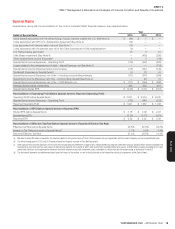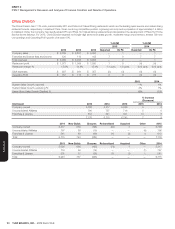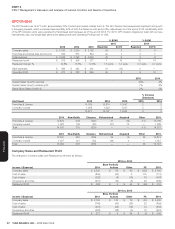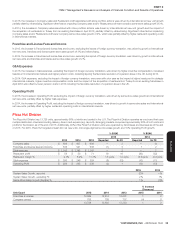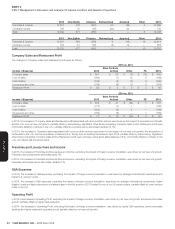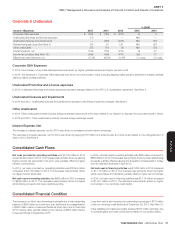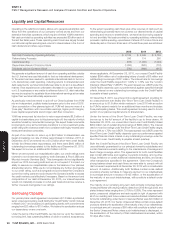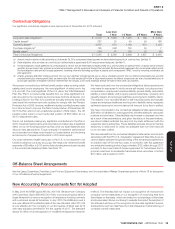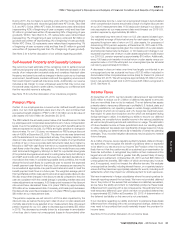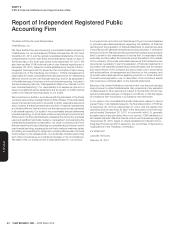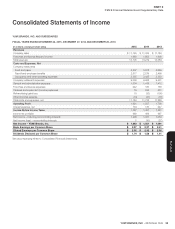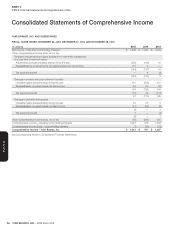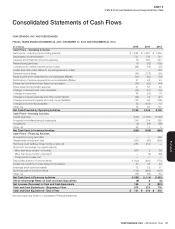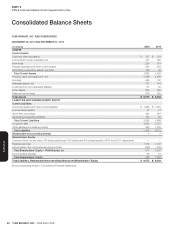Pizza Hut 2015 Annual Report Download - page 136
Download and view the complete annual report
Please find page 136 of the 2015 Pizza Hut annual report below. You can navigate through the pages in the report by either clicking on the pages listed below, or by using the keyword search tool below to find specific information within the annual report.
YUM! BRANDS, INC.-2015 Form10-K28
Form 10-K
PART II
ITEM7Management’s Discussion and Analysis of Financial Condition and Results of Operations
Liquidity and Capital Resources
Operating in the retail food industry allows us to generate substantial cash
flows from the operations of our company-owned stores and from our
extensive franchise operations which require a limited YUM investment.
Net cash provided by operating activities has exceeded $2 billion each of
the last five fiscal years. These operating cash flows have largely funded
our historical capital spending and returns to shareholders in the form of
cash dividends and share repurchases.
To the extent operating cash flows plus other sources of cash such as
refranchising proceeds have not covered our desired levels of capital
spending and returns to shareholders, we have had borrowing capacity
to fund shortfalls. Net cash provided by operating activities, refranchising
proceeds, capital spending, repurchases of shares of Common Stock and
dividends paid on Common Stock each of the last three years are as follows:
2015 2014 2013
Net Cash Provided by Operating Activities $ 2,139 $ 2,049 $ 2,139
Refranchising Proceeds 246 114 260
Capital spending (973) (1,033) (1,049)
Repurchase shares of Common Stock (1,200) (820) (770)
Dividends paid on Common Stock (730) (669) (615)
We generate a significant amount of cash from operating activities outside
the U.S. that we have used historically to fund our international development.
To the extent we have needed to repatriate international cash to fund our
U.S. discretionary cash spending, including returns to shareholders and
debt repayments, we have historically been able to do so in a tax-efficient
manner. If we experience an unforeseen decrease in our cash flows from
our U.S. businesses or are unable to refinance future U.S. debt maturities
we may be required to repatriate future international earnings at tax rates
higher than we have historically experienced.
As previously noted we intend to spin-off our China business from YUM
into an independent, publicly-traded company prior to the end of 2016.
Upon completion of the planned spin-off, YUM will become more of a
“pure play” franchisor with more stable earnings, higher profit margins,
lower capital requirements and stronger cash flow conversion.
YUM has announced its intention to return approximately $6.2 billion of
capital to shareholders prior to this planned spin-off, the majority of which
would be funded by incremental borrowings. We expect these incremental
borrowings to occur as the Company transitions to a non-investment grade
credit rating with a balance sheet more consistent with highly-levered peer
restaurant franchise companies.
As part of our intention to return up to $6.2 billion to shareholders, we
began increasing our rate of share repurchases in October, 2015. In
December, 2015 we entered into a $1.5 billion short-term credit facility
to help fund these share repurchases, and there were $600 million of
outstanding borrowings related to this facility as of December 26, 2015.
We expect to borrow an additional $5.2 billion in 2016.
When we announced our recapitalization plan, our credit ratings were
lowered to non-investment grade by both Standard & Poor’s (BB) and
Moody’s Investor Services (Ba3). This downgrade did not significantly
impact our 2015 borrowing costs and we do not expect it to impact our
ability to execute our recapitalization plan or the balance of our planned
shareholder returns. While we do not anticipate any further downgrade
to our credit rating, such a downgrade would increase the Company’s
current borrowing costs and could impact the Company’s ability to access
the credit markets cost effectively if necessary. Based on the amount and
composition of our debt at December 26, 2015, our interest expense
would not materially increase on a full-year basis should we receive a
further one-level downgrade in our ratings.
Borrowing Capacity
Our primary bank credit agreement comprises a $1.3 billion syndicated
senior unsecured revolving credit facility (the “Credit Facility”) which matures
in March 2017 and includes 24 participating banks with commitments
ranging from $23 million to $115 million. We believe the syndication reduces
our dependency on any one bank.
Under the terms of the Credit Facility, we may borrow up to the maximum
borrowing limit, less outstanding letters of credit or banker’s acceptances,
where applicable. At December 26, 2015, our unused Credit Facility
totaled $594 million net of outstanding letters of credit of $5 million and
outstanding borrowings of $701 million. The interest rate for borrowings
under the Credit Facility ranges from 1.00% to 1.75% over the “London
Interbank Offered Rate” (“LIBOR”). The exact spread over LIBOR under the
Credit Facility depends upon our performance against specified financial
criteria. Interest on any outstanding borrowings under the Credit Facility
is payable at least quarterly.
On December 8, 2015, we entered into a credit agreement providing for
an unsecured term loan facility (the “Short-Term Loan Credit Facility”) in
an amount up to $1.5 billion which matures in June 2016 with an option
for YUM to extend maturity for an additional three months and includes
three participating banks. This credit agreement is being used to fund a
portion of our planned capital returns to shareholders.
Under the terms of the Short-Term Loan Credit Facility, we may
borrow up to the full amount of the facility in up to three draws. At
December 26, 2015, our unused Short-term Loan Credit Facility totaled
$900 million net of outstanding borrowings of $600 million. The interest
rate for most borrowings under the Short-Term Loan Credit Facility ranges
from 1.00% to 1.75% over LIBOR. The exact spread over LIBOR under the
Short-Term Loan Credit Facility depends upon our performance against
specified financial criteria. Interest on any outstanding borrowings under the
Short-Term Loan Credit Facility is payable at least quarterly.
Both the Credit Facility and the Short-Term Loan Credit Facility are
unconditionally guaranteed by our principal domestic subsidiaries and
contain financial covenants relating to the maintenance of leverage and
fixed charge coverage ratios. The agreements for both credit facilities
also contain affirmative and negative covenants including, among other
things, limitations on certain additional indebtedness and liens, and certain
other transactions specified in the agreement. Given the Company’s
strong balance sheet and cash flows we were able to comply with all
debt covenant requirements at December 26, 2015 with a considerable
amount of cushion. Additionally, both facilities contain cross-default
provisions whereby our failure to make any payment on our indebtedness
in a principal amount in excess of $125 million, or the acceleration of
the maturity of any such indebtedness, will constitute a default under
such agreement.
The majority of our remaining long-term debt primarily comprises Senior
Unsecured Notes with varying maturity dates from 2016 through 2043 and
stated interest rates ranging from 3.75% to 6.88%. The notes represent
senior, unsecured obligations and rank equally in right of payment with
all of our existing and future unsecured unsubordinated indebtedness.
Amounts outstanding under Senior Unsecured Notes were $2.5 billion at
December26, 2015. Our Senior Unsecured Notes contain cross-default
provisions whereby the acceleration of the maturity of any of our indebtedness
in a principal amount in excess of $50 million will constitute a default under
the Senior Unsecured Notes unless such indebtedness is discharged, or
the acceleration of the maturity of that indebtedness is annulled, within
30 days after notice.



